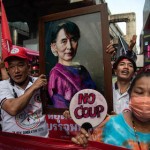Myanmar, the physical gateway and link between South Asia and Southeast Asia, continues to be “the sick man of the region”. Thirty-two months after the 2021 military coup, the nation remains mired in a cycle of violence between the military and opposition forces, bringing untold misery to the people, denial of humanitarian aid, and eroding political stability. In the preceding weeks, numerous diplomatic efforts were made in the quest for a solution. What has been the overall impact, and what are the immediate possibilities for this unfortunate nation that has had to put up with military rule for 60 years since independence in January 1948? Can it find its way back to the past decade of at least limited democracy which ran from March 2011 to January 2021?
A careful review of recent political and security developments reveals several important trends. First, battles between army units and People’s Defence Force continue in various parts of the country, including the Burmese heartland. Consequently, the army has been under pressure to recruit more and to stop losing control over territory.
A former army officer who defected to the opposition observed, “The regime lacks combat forces. The casualties keep rising and soldiers are sent from checkpoints to the frontlines, leaving gaps.” Second, continued fighting has resulted in the internal displacement of over 1.6 million people, with tens of thousands of Burmese seeking shelter in neighbouring countries, according to the UN Office for the Coordination of Humanitarian Affairs.
Second, reports of airstrikes by the air force on the positions of the Kachin Independence Army (KIA), the ethnic rebels, point to an attempt to block the flow of supplies to opposition troops in the west. There has been intense fighting along the Myitkyina-Bhamo road in the past three months to gain control of the major cities such as Hpakant, Bhamo and Myitkyina. Sagaing has been a centre of armed resistance against the army. Other reports showed that the army lost 62 military camps in southeastern Myanmar due to the attack by the Karen National Liberation Army (KNLA) between February 2021 and July 2023.
Third, the State Administration Council (SAC), the regime’s top body, has been “reorganised” at least five times since 2021, with 15 members including three generals removed as a result. These reshuffles point to “instability within the regime”. The fact that the army leadership announced its plan to hold parliamentary elections in August, which it failed to organise, is another pointer to its vulnerability.
Finally, the breakdown of relations between the army and the country’s principal political party — the National League for Democracy (NLD) — remains complete. The regime has arrested and jailed nearly 2,000 members of NLD since the coup. Of them, at least 1,269 were still under detention at September’s end. Meanwhile, the latest news about the rejection by the Myanmar Supreme Court of the appeals by NLD supremo Aung San Suu Kyi against the long sentences given to her has generated much concern, especially as she suffers from serious health issues.
Turning to regional diplomacy, ASEAN has been at the forefront of making efforts to craft a solution to the Myanmar crisis. The grouping issued on September 23, the “review and decision” on the implementation of the Five-Point Consensus (FPC) which was adopted in 2021. In a 19-paragraph document, ASEAN condemned the continued acts of violence in Myanmar, maintained that FPC remained as “the main reference” to address the political issues that should be implemented “in its entirety”, urged the Myanmar army “in particular” to de-escalate violence, and reiterated that the ASEAN would continue to work for “an inclusive and durable peaceful resolution”.
Further, ASEAN decided to continue barring Myanmar’s participation in political-level meetings and took a new decision that the ASEAN Chair in 2026 would go to the Philippines, skipping Myanmar. All this reflected the grouping’s deep frustration with the regime and its recognition that a solution may elude it for long.
A day earlier, the Quad foreign ministers representing Australia, India, Japan and the U.S. issued a joint statement after their meeting in New York. It called for a resolution through “constructive dialogue” and “a return to Myanmar’s transition towards inclusive federal democracy.” Meanwhile, the latest round of Track 1.5 Dialogue on Myanmar was hosted by the new ASEAN chair — Laos — on September 22. This platform groups together Myanmar’s immediate neighbours and a few ASEAN members. Nothing much filtered into the public domain about the outcome, except that the participants focused on the range of transnational crimes that had increased due to the prolonged crisis and its adverse impact on Myanmar and the neighbouring countries.
Finally, Thailand — the Chair and the next host of the BIMSTEC summit — is now struggling with the question of Myanmar’s participation in it. Initial reports suggested that Myanmar’s top general Min Aung Hlaing may be invited to the summit due on November 30. These were met with unofficial denials. At the Colombo summit in March 2021, the Myanmar leader was not a participant. That pattern is likely to be repeated for the forthcoming summit, which is now unlikely to take place in 2023.
Given the ground situation and the failure of regional diplomacy so far, it is clear that Myanmar’s nightmare may continue for a long time.
Rajiv Bhatia is Distinguished Fellow, Foreign Policy Studies, and a former ambassador.
This article was first published by Hindustan Times.


